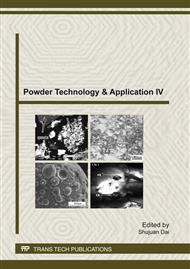[1]
X.Wang, G.Zhang, PTC effect of carbon fiber filled EPDM rubber composite, J. Mater. Sci. Mater. Electron. Vol.19 (2008), p.1107
DOI: 10.1007/s10854-007-9476-1
Google Scholar
[2]
X. Zhang, Y. Pan, Q. Zheng, et al. A new polymer composite thermistor having double PTC transitions, J. Appl. Polym. Sci. Vol.78 (2000), p.426
DOI: 10.1002/1097-4628(20001010)78:2<424::aid-app220>3.0.co;2-6
Google Scholar
[3]
Z. Su, C. Li, The study of the super-stability of carbon filled PTC blends containing UHMWPE, Plastic Sci.& Tech. Vol.4 (2001), p.6
Google Scholar
[4]
C. Chan, C. Cheng, Electrical properties of polymer composites prepared by sintering a mixture of carbon black and ultra-high molecular weight polyethylene powder. Polymer Engineering and Science. Vol.37 (1997), p.1127.
DOI: 10.1002/pen.11757
Google Scholar
[5]
J. Zhang, Q. Zhang, Y. Yang, et al. High-density polyethylene/carbon black conductive composites. II. Effect of electron beam irradiation on relationship between resistivity-temperature behavior and volume expansion, J. Appl. Polym. Sci. Vol.83 (2002), p.3118.
DOI: 10.1002/app.10050
Google Scholar
[6]
S.J. Park, H. C. Kim, H. Y. Kim, Roles of work of adhesion between carbon blacks and thermoplastic polymers on electrical properties of composites, J. Coll. Inter. Sci. Vol.255 (2002), p.145
DOI: 10.1006/jcis.2002.8481
Google Scholar
[7]
M.O. Lisunova, Y.P. Mamunya, N.I. Lebovka, et al. Percolation behaviour of ultrahigh molecular weight polyethylene/multi-walled carbon nanotubes composites, European Polymer Journal, Vol.43 (2007), p.949
DOI: 10.1016/j.eurpolymj.2006.12.015
Google Scholar
[8]
J.H. Lee, S.K. Kim, N.H. Kim, Effects of the addition of multi-walled carbon nanotubes on the positive temperature coefficient characteristics of carbon-black-filled high-density polyethylene nanocomposites, Scripta Materialia. Vol.55 (2006), p.1119
DOI: 10.1016/j.scriptamat.2006.08.051
Google Scholar
[9]
S. Jiang, Y. Yu, J. Xie, et al, Positive temperature coefficient properties of multiwall carbon nanotubes/poly(vinylidene fluoride) nanocomposites, J. Appl. Polym. Sci. Vol.116 (2010), 838-842.
DOI: 10.1002/app.31569
Google Scholar
[10]
I. Mironi-Harpaz, M.Narkis, Electrical behavior and structure of polypropylene/ultrahigh molecular weight polyethylene/carbon black immiscible blends, J. Appl. Polym. Sci. Vol.81 (2001), p.104
DOI: 10.1002/app.1419
Google Scholar
[11]
C. Zhang, C. Ma, P. Wang, et al. Temperature dependence of electrical resistivity for carbon black filled ultra-high molecular weight polyethylene composites prepared by hot compaction, Carbon, Vol.43 (2005), p.2544
DOI: 10.1016/j.carbon.2005.05.006
Google Scholar
[12]
R. Pfeffer, N.D. Rajesh, D.G. Wei, et.al., Synthesis of engineered particulates with tailored properties using dry particle coating, Powder Technology. Vol.117 (2001), p.46
DOI: 10.1016/s0032-5910(01)00314-x
Google Scholar
[13]
X. Hao, G. Gai, Y. Yang, et.al., Development of the conductive polymer matrix composite with low concentration of the conductive filler, Materials Chemistry and Physics. Vol.109 (2008), p.15
DOI: 10.1016/j.matchemphys.2007.10.044
Google Scholar


